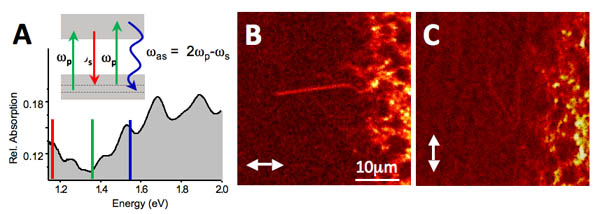Reports: G6
46067-G6 Single Molecule Vibrational Coherence on a Carbon Chain
1. Research goal
We aim to measure the vibrational motion of two CH2 oscillators on a hydrocarbon chain and determine their mutual correlation. Such measurements will reveal important information on the ultrafast structural motions in the chain, essential molecular dynamics that has remained inaccessible thus far. The mutual correlation of two vibrating molecular groups can only be probed on a single molecule level. We, therefore, propose a series of coherent vibrational spectroscopy experiments on a single molecule, the very first of their kind.
2. Research steps taken
In order to measure nonlinear coherent signals from single molecules, an amplification method for enhancing weak optical signals has to be developed. The most suitable mechanism for signal enhancement is the use of plasmonic materials for surface enhanced emission from molecules. In year one of this project we have investigated the efficiency the surface enhanced coherent Raman anti-Stokes effect. This effect was found to be surprisingly small. In the first year we established that when plasmonic materials are illuminated with ultrafast pulses, nonlinear emission from the plasmons is the dominant mechanism that contributes to the signal. The inherent plasmon emission is overwhelming surface enhanced signal contributions from the molecules. Due to this intrinsic complication, clear surface enhanced coherent anti-Stokes signals from molecules have not been convincingly measured.
In year two, we have taken another approach to bring the sensitivity of coherent nonlinear microscopy into the single molecule range. We have focused on carbon systems with an intrinsically strong polarizibility. Our first choice was the carbon nanotube, a molecular system known for its enhanced optical properties. We accomplished the following:
a) We were successful in preparing carbon nanotube samples that can be examined in a nonlinear optical microscope. Nanotubes were grown on a quartz coverslip, which allowed optical probing directly through the coverslip.
b) We have achieved coherent four-wave-mixing experiments on individual single-walled carbon nanotubes. These measurements represent the first reproducible nonlinear coherent optical signals ever measured from an individual molecular compound. See Figure 1.
c) We have observed that the four-wave-mixing signals are enhanced by the electronic resonances in the carbon nanotube, as determined from polarization dependent measurements.

Figure 1. Nonlinear imaging of individual carbon nanotubes. (A) Absorption spectrum of carbon nanotube sample and the relative energies of the pump (green), probe (red) and anti-Stokes (blue) radiation. The inset shows the energy level diagram relevant to the FWM process. (B) FWM image of a single nanotube when polarization of the pump/Stokes excitation fields is parallel to the long axis of the nanotube. (C) Same tube when the excitation is polarized perpendicular to the nanotube's long axis.
3. Prospects
The success of four-wave-mixing experiments on single molecular compounds is based on using the intrinsic electronic resonances of molecules for signal enhancement rather than the field enhancement provided by plasmon modes of metallic substrates. This insight opens many doors for measuring the nonlinear response from bond vibrations. We will first use the coupling of electronic resonances of nanotubes to vibrational modes for enhancing the vibrational response of the carbon network. When successful, this mechanism is used to enhance the signal from individual substituted point-defects on the carbon nanotube. We expect that we can measure correlations of substituted CH oscillators on the carbon nanotube host system.
4. Impact of PRF grant on career
The PRF grant has enabled a highly ambitious program in our group. The quest to measure nonlinear coherent signals from single molecules has shed light on several fundamental physicochemical mechanisms: from understanding plasmonic enhancement in the nonlinear regime to discovering the possibility of inducing nonlinear coherent signals from single molecular systems through electronic enhancement. Without the PRF funding, we would not have been able to address these challenging problems. All the work reported has been carried out by my graduate student Hyunmin Kim, who was supported by the PRF funds and has received a thorough training in nonlinear molecular microscopy. Hyunmin Kim has now successfully completed his graduate studies and has found a postdoctoral position at a reputable research institute.




